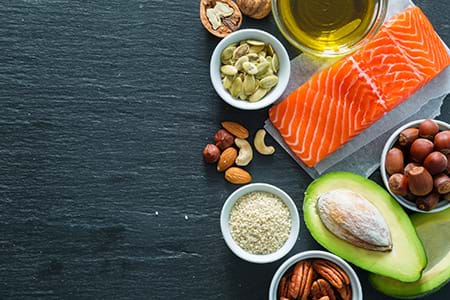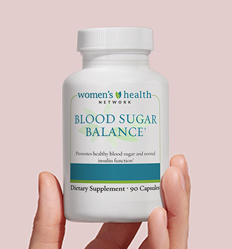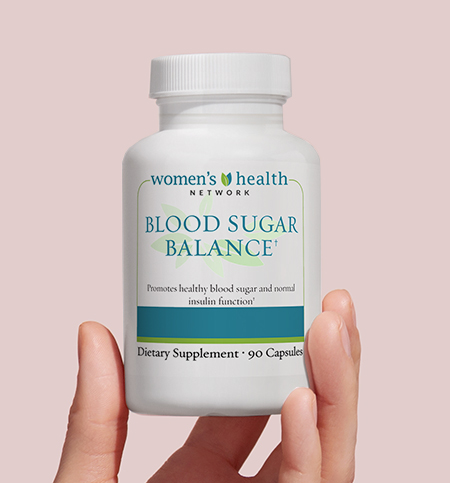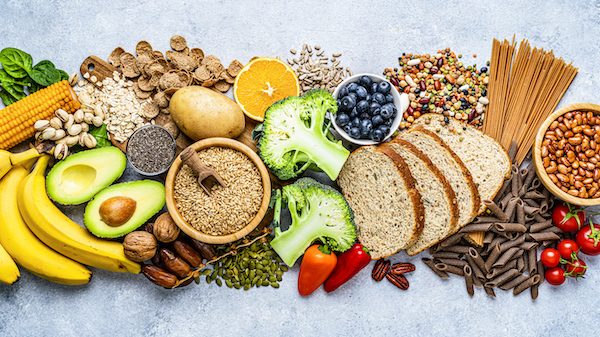Authored by Dr. Amber Hayden, DO
One thing we know for certain about insulin resistance, diabetes and metabolic syndrome is that they are intimately related to nutrition. At Women’s Health Network, we regard insulin resistance as the perfect opportunity to make changes in your diet that can keep blood glucose stable. But having diabetes makes it mandatory to do all the things we encourage women to do anyway, especially eating balanced meals.

We are all well-served when we eat from the four food groups by choosing fresh colorful vegetables and fruits, whole grains, and rich sources of protein and healthy fats (as well as avoiding heavily processed foods such as high-fructose corn syrup and trans fats). Balance is as essential in diabetes as it is in overall health — it’s just that it’s no longer an option!
To underscore the importance of balance in controlling blood glucose, we’ve compiled an overview of the four food groups — protein, fat, complex carbohydrates and fiber. We encourage you to include them in all your meals and snacks daily.
Keep in mind as you read below that in terms of energy, the two hormones that are most influential when it comes to what we store in our bodies and what we use are insulin and glucagon. In broad terms, you can think of insulin as the “storer” of nutrients and glucagon as the “mobilizer” of nutrients. Insulin opens cell doors to take glucose out of the blood stream and shuttle it into your cells. Meanwhile glucagon stimulates the release of glucose into the blood stream.
Proteins provide balance for insulin
Protein is essential for life. We use it to build and repair our bodies (including our bones, cells, muscles, enzymes, hair, nails, hormones and neurotransmitters). We use it to help us burn fat and help fight off infection and inflammation.
When your blood sugar is low before eating, your pancreas releases a hormone called glucagon. Its main purpose — in contrast to insulin’s — is to mobilize stored glucose and prevent hypoglycemia. Eating a very protein-rich meal will also cause your pancreas to release glucagon. This is why high-protein diets work for a while in helping people lose weight. But a gentler way to support lasting weight loss is by not going whole hog on proteins, but not scrimping on them, either. By including some protein in all your meals and snacks you can even out the see-saw action between insulin and glucagon. Protein will help counterbalance the surge of insulin caused by the carbohydrate content in your meals. This helps prevent your body from hoarding the energy in the sugars, storing it in your cells or converting it to fat.
Consider plant proteins
The average woman needs to consume about 60–70 grams of protein a day. But counting up your grams of daily protein isn’t really necessary unless you think you’re not getting enough or, on the other hand, overdoing it. Good sources of animal protein include eggs, fish, poultry, lean meats and cheese. But protein sources are also found abundantly in the plant world in seeds, nuts, legumes and soy foods such as tofu, tempeh and soy milk. And there is strong evidence to suggest that we would all enjoy better health and hormonal balance by upping the plant protein and cutting back on the animal protein in our diets. Another way to boost protein intake is by combining whole grains with any of the above-listed protein sources in your meals and snacks.
Fats
Like protein, fat is essential for life. It is an integral part of every cell membrane in our bodies and comprises about a third of our brains. So despite any recent fads in low-fat dieting, it is clear that eating fat is fundamental to health and well-being! Among its many roles, fat is crucial to maintaining adequate hormonal balance, stabilizing blood sugar, increasing immunity, supplying energy and controlling hunger.
How does fat help to regulate hunger? One of the key players in satiety, or that lovely sense of satisfaction we get from our food, is cholecystokinin (CKK). It is a peptide hormone that triggers a sense of fullness. When we eat fat, our intestinal and stomach walls secrete CKK, which helps with the digestion of fat and protein. This kicks in about 8–20 minutes after we begin to eat, particularly when there is good fat and/or protein content in the meal. Again, the release of this hormone in the stomach and intestines is triggered by fat and protein content in our food. CKK apparently stimulates the vagus nerve with a message to “stop eating.” It also helps turn off ghrelin, the hormone of appetite, which triggers the sensation of fullness.
Whenever you feel hungry between meals you can test this mechanism by eating a small handful of nuts, such as almonds or walnuts, to trigger the release of CKK. Within 20 minutes you should note the hunger pangs abate!
Fat also slows down the processing of food in your digestive tract. This means that by including it in your meals and snacks you lower the overall glycemic load. This makes for steadier blood sugar levels over time and nice long-lasting satisfaction after eating.
But just as it’s important to recognize that fat is good for you, it’s important to eat healthy kinds of fats — natural fats. There are three kinds of natural fats: saturated, monounsaturated and polyunsaturated. All three of these fats are okay to eat because they are natural and your body can digest them. But it’s the polyunsaturates that rank as stars in maintaining health.

Avoid damaged fats
Damaged fats, including oxidized or rancid fats, trans-fatty acids and hydrogenated fats, are what you should take care to avoid. These are fats whose chemical structures have been altered in such a way that your body cannot metabolize them. These fats build up as cellular debris and can eventually damage cells and disrupt their function.
In a study published in 2001 of nearly 85,000 women followed over 14 years, it was found that trans-fatty acids increase and polyunsaturated fatty acids reduce risk of type 2 diabetes. The authors concluded that substituting nonhydrogenated polyunsaturated fatty acids for trans fatty acids in the diet is likely to reduce the risk of type 2 diabetes substantially. Although no direct causal link between the effects of trans fatty acids and diabetes was identified, in the presence of underlying insulin resistance, researchers felt trans fats increase the probability of developing clinical disease.
As an aside, we’d like to think that the publication of this study in 2001 is helping to break the pattern the food industry has of loading commercially produced foods with damaging trans fats. We’ve known since the 1970s that trans fats are bad for us. But they remain common in prepackaged and processed foods such as brand name peanut butters, margarines, non-dairy creamers, imitation mayonnaise, deep fried foods and fast foods.
It’s interesting that it has taken over 30 years for fast-food chains such as McDonald’s and Kentucky Fried Chicken to agree to eliminate them from their menus. Even so, the food industry is permitted to label foods with “zero trans fats” if they contain less than a gram per serving. So be sure to check the labels for serving size — if you see they’re really small, they’re probably hiding something. The December 2006 decision by the people of New York City to ban these artery-clogging fats altogether from their streets shows us that given adequate information, people are prepared to take their health into their own hands. One more good reason to love NYC!
Carbohydrates stimulate insulin release
Carbohydrates are recognized by our bodies as sugar that gives us immediate energy. They stimulate the release of insulin. And if they’re not used right away as fuel, they’ll be stored as fat in your body. So it is important to think about your activity level when consuming carbs.
Unlike fat and protein, carbohydrates may not trigger a signal to your brain that you are full. If your meal is high in carbs, but contains little to no fat or protein, less CKK gets released as you begin to eat. So Mother Nature’s in-built satisfaction mechanism is less likely to kick in and do its job. And you are more likely to continue to eat, or overeat, without feeling satisfied! Moreover, a high-GI meal may result in a return in your body of high levels of ghrelin sooner than do meals containing adequate protein and fat. So you are likely to feel hungry again sooner.
But don’t let this information tempt you to avoid carbs altogether. Why not? Because eating a diet with zero carbohydrates causes insulin levels to drop even further, which not only starves the cells of energy (the very situation diabetics are trying to avoid), but upsets the insulin–glucagon balance. This can lead to depression, fatigue, insomnia and bone loss. Additionally, our brains need glucose from carbohydrates to function properly.
To keep your insulin–glucagon ratio balanced, it is important to consume carbohydrates with a low glycemic index (GI). This means eating carbs found in whole grains, fruit and vegetables — known as complex carbohydrates. Complex carbohydrates break down more slowly in the digestive tract. This results in a less dramatic surge in blood glucose levels and more efficient metabolism.
Fiber/non-starchy veggies
Non-starchy vegetables contain fiber and loads of important vitamins, minerals and micronutrients for your body. These micronutrients hold information that speaks to your cells and genes to keep all your systems in balance — including the endocrine system, whose main players are insulin and glucagon. Because of their low glycemic index, it isn’t necessary to keep track of the carbohydrates you are consuming while eating non-starchy vegetables. There is an endless variety, color and texture to choose from this group. Eat as many as you like — the more the better!
By planning to include each of the above food groups in your meals and snacks, you can regulate your blood sugar levels better and supply your body with the abundant raw materials it needs to constantly rebuild healthy cells, tissues and organs.
References and further reading
Wikipedia. 2008. Glucagon. URL: https://en.wikipedia.org/wiki/Glucagon (accessed 01.27.2008).
Bowen, R. 1999. Glucagon. URL: https://www.vivo.colostate.edu/hbooks/pathphys/endocrine/pancreas/glucagon.html (accessed 01.27.2008).
The science behind appetite. CTV.ca. URL: https://www.ctv.ca/servlet/ArticleNews/story/CTVNews/20061112/diet_appetite_061112/20061115/ (accessed 12.18.2006).
Clandinin, M., & Wilke, M. 2001. Do trans fatty acids increase the incidence of type 2 diabetes? Am. J. Clin. Nutr., 73 (6), 1001–1002.
Salmerón, J., et al. 2001. Dietary fat intake and risk of type 2 diabetes in women. Am. J. Clin. Nutr., 73 1019–1026.
Lunn, J., & Buttriss, J. 2007. Carbohydrates and dietary fibre. Nutrition Bulletin, 32 (1), 21–64. URL: https://www.blackwell-synergy.com/doi/full/10.1111/j.1467-3010.2007.00616.x (accessed 01.18.2008).
Bowen, J., et al. 2006. Appetite regulatory hormone responses to various dietary proteins differ by Body Mass Index status despite similar reductions in ad libitum energy intake. J. Clin. Endocrin. Metab., 91 (8), 2913–2919. URL (full text): https://jcem.endojournals.org/cgi/content/full/91/8/2913 (accessed 01.09.2008).
Bowen, J., et al. 2006. Energy intake, ghrelin, and cholecystokinin after different carbohydrate and protein preloads in overweight men. J. Clin. Endocrin. Metab., 91 (4), 1477–1483. URL (full text): https://jcem.endojournals.org/cgi/content/full/91/4/1477 (accessed 01.09.2008).











